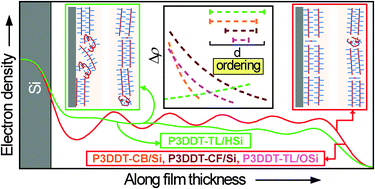Solvent dependent ordering of poly(3-dodecylthiophene) in thin films†
Abstract
The strong influence of solvents on the ordering of poly(3-dodecylthiophene) (P3DDT) due to edge-on oriented stacking, in the spin-coated thin film on the Si substrate, both near the substrate and away from it, depending upon the substrate surface nature, is observed from the X-ray reflectivity study. The absence of any appreciable amount of coil-like P3DDT chains (i.e. charge localized states) and formation of π-stacked aggregates (i.e. charge delocalized states) in the spin-coated thin films, with slightly better uniformity for the film prepared from toluene (TL) compared to that prepared from chloroform (CF) and chlorobenzene (CB), are well evident from the optical absorption study. No ordering near the weakly hydrophobic H–Si substrate is found in the films prepared from TL, probably due to less diffusion of P3DDT in TL and the appreciable pinning (film–substrate interaction) effect, while appreciable ordering near the film–air interface, overcoming the pinning effect, is likely to be related to the moderate values of the viscosity and the evaporation rate of the solvent. A better ordered Form-I-like relaxed structure near the film–substrate interface and a less ordered interpenetrating Form-II-like structure toward the film–air interface are found in the films prepared from CF, probably related to the low viscosity and high evaporation rate, respectively, of the solvent. Less ordered and mixed but more toward Form-II-like structures are formed throughout the film prepared from CB, probably due to the high viscosity of the solvent, even though its evaporation rate is low. The high evaporation rate of CF and high viscosity of CB probably create hindrance in the formation of continuous films on the weakly hydrophilic O–Si substrate at low speed, while the moderate values of both the parameters for TL, help to form continuous films on the O–Si substrate even at low speed. Such moderate values also help to form less variable (and more toward Form-I-like) structures and better ordering in the latter film. The relative fluctuation between aggregates along the film-thickness is, however, found slightly more in the film prepared from TL compared to that prepared from CF.


 Please wait while we load your content...
Please wait while we load your content...